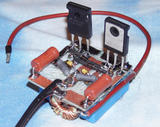This is my favorite flyback driver:
circuit description:
The most crucial part of the circuit are the MKP capacitor and the flyback primary winding. Keep really shorts the connections between the resonant circuit (capacitor - flyback) and the mosfets. The primary is hand wound on the flyback, 4+4 turns of heavy wire, can be done with some bifilar to make things simpler. Use a STRONG capacitor, at least rated AC 5x your supply voltage, possibly an high current mkp one.
It's rather easy to build, you can choose to put it together on a small heatsink if you're planning to get high power off it or you are using high loss fets, or it can be made "on the fly", since each fet will dissipate only while feeding the zvs circuit, so RDSon * (Isupply/2)^2 * 0.5. normally its a small power, average less than a couple of watts per fet.
Pulloff diodes are soldered directly between the gate and the opposite drain of the mosfets.
The inductor is not crucial, you can also use an old inductor off a pc psu filtering, using the thickest wires ther (normally 5V ones). chose something between 50 and 300µH.
Output frequency is chosen by the flyback's primary and the cap, as usual F= 1 / ( 2pi * sqrt ( L C ) ).
some pics of the driver:





power output can be pushed from some ten's of watts to many hundreds... I've ran some flybacks over the 500W level with this circuit, pretty incredible driver










